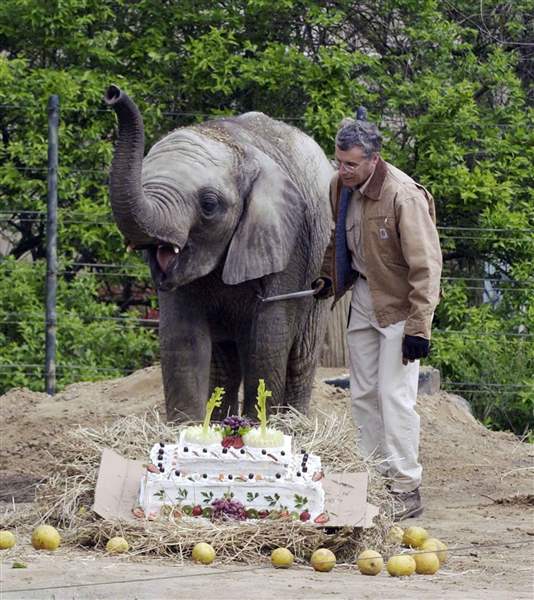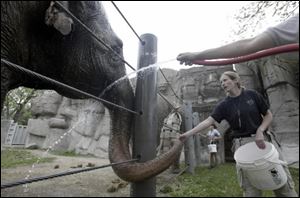
Attack on Toledo keeper rekindles debate on zoo elephants
7/11/2010
Toledo Zoo's African elephant Louie celebrates his second birthday in April, 2005. Louie injured one of his trainers on July 1, though it is unclear exactly what happened.
BLADE PHOTO
The Toledo Zoo's star elephant, "Baby Louie," isn't quite so cute these days.
Since the 7-year-old African pachyderm attacked and critically injured his trainer, Don RedFox, on July 1, zoo employees have been keeping their distance, attending to him only from behind a protective barrier.
Zoo officials and experts have been puzzling over the attack, trying to understand why it happened.
"I think it was just a fluke at this particular time," Alan Roocroft, an international expert on elephants, said last week after an initial assessment of the issue. He said it didn't appear that the 4,000-pound animal intended to seriously harm Mr. RedFox, who had worked with the animal since its birth.
Although it may never be clear what motivated the attack, it has added fire to a debate among elephant experts, zoo administrators, and animal-rights activists about the suitability of keeping elephants in captive settings, particularly in cold climates such as Toledo's. It also has prompted demands from activists that the zoo review its elephant-handling methods.
Clearly, not all zoos have had an easy time keeping elephants. Over the last two decades, 18 zoos across the country have either closed their elephant exhibits or decided to phase them out, according to a list compiled by the California-based group In Defense of Animals. Reasons cited include lack of space or money to expand the exhibits, concerns about climate, and difficulties keeping the animals healthy. The zoos include the Alaska Zoo, the Bronx Zoo in New York, Chicago's Lincoln Park Zoo, the Detroit Zoo, and the Philadelphia Zoo.

Wanda, a female Asian elephant, was moved from the Detroit Zoo, above, to an animal sanctuary in California along with the zoo's other elephant, Winky, in 2005. The decision was made after years of trying to improve the elephant's environment.
The Detroit Zoo is thought to be the first to close its elephant exhibit voluntarily and on purely ethical grounds. In 2005, the zoo sent its two Asian elephants, Winky, 51, and Wanda, 45, to an animal sanctuary in California. Executive Director Ron Kagan said the decision was made after years of trying to improve the elephants' environment and handling methods at the zoo, all of which failed.
"We finally said that, with every improvement we make, whether with space or protocol, none of those things seemed to ultimately lead to elephants thriving," Mr. Kagan explained. "We just said, if they're not going to thrive, we're not going to keep them."
He said the elephants at the zoo suffered from ailments common among elephants in captivity.
Those include foot and skin problems, psychological issues related to stress, such as pacing and swaying, reproductive problems, and short life spans.
The director linked those problems to lack of space for the animals compared with their habitat in the wild - at the Detroit Zoo the elephant exhibit was 1.5 acres - to restraints on social interaction with other elephants while in captivity and to chilly winters, which can lead to elephants spending a lot of time indoors.
"Captivity for a lot of animals presents challenges, just as certain captive situations present challenges for humans," Mr. Kagan said. "The issue is how you cope. Some cope well and others don't cope so well."
Although opinions on elephant behavior and coping skills vary among professionals, some experts believe space restrictions can lead to mental stress and even aggression.
Pat Derby, a founder of the Performing Animal Welfare Society sanctuary in San Andreas, Calif., which took in the Detroit Zoo's duo among others, said she's seen a positive transformation in the behavior of zoo and circus elephants after they arrive at her 2,300-acre sanctuary.
"Elephants are so intelligent and they're so complex, they're just bored to tears in most zoos," said Ms. Derby, who has not visited the Toledo Zoo. "The effect of space and freedom of choice is huge - it's miraculous."
Nevertheless, Anne Baker, executive director of the Toledo Zoo, strongly rejected the notion that Louie or the other two elephants at the zoo could be under stress. She said the elephants - whose exhibit is 0.7 acre and will be expanded to just over 1 acre in 2012 - receive plenty of stimulation and exercise and show no signs of mental stress. All of the elephants can go outdoors in the winter unless the ground is slippery, Ms. Baker said. "There's good evidence that elephants have a lot more problems with heat than they do with cold," the director said.
Ms. Baker said she thinks Louie's behavior was most likely the result of hormonal fluctuations as the young elephant approaches adolescence.
The Association of Zoos and Aquariums, which accredits the Toledo Zoo, also rejected concerns about space restrictions and climate.
Spokesman Steve Feldman said elephants are very adaptable. He said association standards for zoo elephant exhibits, such as Toledo's, are higher than those required by the federal government and they ensure the animals are comfortable and well cared for. He also pointed to successful elephant breeding programs in cold climates, such as at the African Lion Safari in Ontario, Canada.
The safari has 16 elephants that roam over its 750-acre park. Many of the elephants were born in Canada and have adjusted to the cold weather, marketing manager Lori Latter said. "They even enjoy playing in the snow," Ms. Latter said, comparing the elephants to children. "They get excited to go around and frolic in the park."
Countering the idea of a trend among zoos to close elephant exhibits, Mr. Feldman said many zoos have expanded their elephant facilities, including those in San Diego, Dallas, Cleveland, and Washington.
"The trend is actually to expand," Mr. Feldman said.
However, for Ms. Derby and two animal rights groups, space and climate conditions at zoos are only part of the concern. Immediately after Louie's attack on Mr. RedFox, In Defense of Animals issued a release blaming the incident on an elephant management system known as "free contact" that is used at many zoos, including in Toledo.
The group People for the Ethical Treatment of Animals took a similar stance.
"Free contact" involves trainers working directly with elephants in their enclosure, as Mr. RedFox did the day he was attacked. It requires the use of a rod with two metal tips, one pointed and one curved.
The zoo and aquarium association and the Toledo Zoo referred to the rod as an "elephant guide" and said it is used to gently touch the elephants and provide them with instructions and does not harm them. Mr. Feldman called the rod a "routine training tool."
PETA and the In Defense of Animals group called the rod a "bull hook" and said it is used to prod, jab, and strike elephants, intimidating them and making them fearful of their trainers. They believed Louie's attack probably was a reaction to that treatment.
"Louie from the day he's been born has been poked and prodded and pushed and manipulated with that bull hook," PETA spokesman Lisa Wathne said. "He knows that if he does not do what is asked of him he will be hurt with the bull hook. At some point, many animals rebel against that."
A list compiled by PETA indicates 64 incidents between 1990 and 2010 in which elephants caused injury or death to people. Most were the result of direct attacks on trainers in circuses. At least 27 incidents occurred at zoos, including one at the Pittsburgh Zoo in 2002 in which an African elephant crushed her trainer to death with her head.
Ms. Derby, who runs the sanctuary in California and worked with elephants for many years in the television and movie industry, called the "free contact" method a "recipe for disaster." She said it is based on antiquated techniques used by circus trainers.
In a 1997 interview published by the American Federation of State, County and Municipal Employees, Mr. RedFox said he learned the commands and techniques for working with elephants from a circus trainer.
"I have no idea what [Mr. RedFox] did, I just know from 45 years' experience of working with elephants that bull hooks instill fear and mistrust," Ms. Derby said. "Their first reaction when they develop beyond
being a juvenile is to sort of attack first and try to see what's happening. I would imagine … that the trainer went in with the young bull to get him to do some behaviors and, whatever he did, apparently the elephant for a second rebelled and charged him."
That kind of speculation angered Ms. Baker, who said training at the zoo is based on positive reinforcement. She said no animal activists have visited the zoo and criticisms by groups such as the animal defense group are not based on facts.
The zoo and acquarium association's Mr. Feldman dismissed the animal defense group as "extremist."
Mr. Kagan of the Detroit Zoo said many zoos no longer use "free contact" but have switched to "protected contact" training. "Protected contact" means that keepers work with elephants from behind a protective barrier. The Toledo Zoo employs both methods.
Mr. Kagan said protected contact is safer for keepers, because the elephants can't hurt them. He said "free contact" involves dominating the elephant and creates a negative relationship with the keeper.
"We just philosophically didn't think we should be doing that," he said.
However, Mr. Kagan declined to comment on events at the Toledo Zoo.
"It's a fine zoo and it has an excellent reputation," he said.
Contact Claudia Boyd-Barrett at: cbarrett@theblade.com
or 419-724-6272.